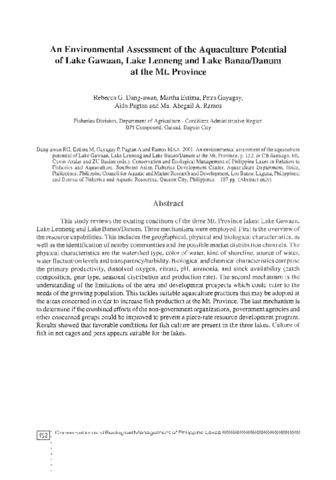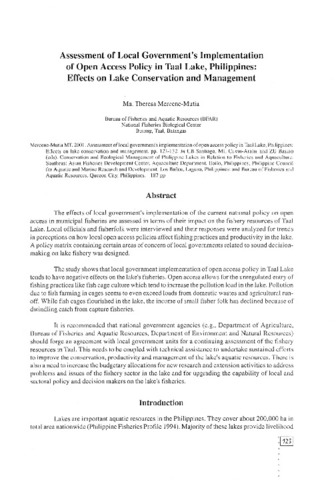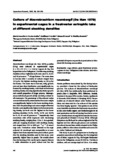| dc.contributor.author | Cuvin-Aralar, M. L. A. | |
| dc.contributor.author | Lazartigue, A. G. | |
| dc.contributor.author | Aralar, E. V. | |
| dc.date.accessioned | 2015-05-19T07:05:42Z | |
| dc.date.available | 2015-05-19T07:05:42Z | |
| dc.date.issued | 2013 | |
| dc.identifier.citation | Cuvin-Aralar, M. L. A., Lazartigue, A. G., & Aralar, E. V. (2013). Net mesh size affects production of giant freshwater prawn Macrobrachium rosenbergii cultured in lake-based cages. Journal of Applied Ichthyology, 29(4), 833-838. | en |
| dc.identifier.issn | 0175-8659 | |
| dc.identifier.uri | http://hdl.handle.net/10862/2233 | |
| dc.description.abstract | Cage culture of freshwater prawns in open waters is prone to the entry of predators and competitors that particularly hamper production. This study was conducted to determine how smaller net mesh sizes to reduce entry of unwanted species inside the cages affects the production of Macrobrachium rosenbergii in lake-based cages. Juvenile prawns were stocked in cages (7 × 7 × 1.5 m) of two net mesh sizes at 10 individuals m-2 and cultured for 10 months in a shallow eutrophic lake in the Philippines. The two net mesh sizes were either 5 mm-mesh B-nets or and 1 mm-mesh Hapa nets. Each treatment had four replicates each and was fed based on biomass with commercially formulated feed. Monitoring of various production parameters was done during the two phases of culture: batch phase on days 63 and 127 and the selective harvest phase on days 187, 219, 253, 281 and 313, when the experiment was terminated. For the first 127 days of culture, the weight, percent weight increase, daily growth rate (DGR), specific growth rate (SGR), yield and feed conversion ratio (FCR) were significantly better in prawns reared in the Hapa compared to the B-nets. During the selective harvest phase the blue claw, orange claw and berried females were selectively harvested and the remaining prawns returned to the cages. After changes in stocking density through culling, ancova was used to compare the effect of mesh size with the total number of prawns returned to the cages as a covariate. Yield was significantly higher in the Hapa nets. Weight, DGR, SGR and FCR were also consistently higher in the Hapa nets, although not always significantly different. The overall better performance of prawns reared in the Hapa net cages was due to: (i) the reduction in the entry of predator and competitor species in the finer-meshed Hapa compared to the larger mesh B-net, (ii) more natural food trapped inside the Hapa cages, and (iii) a higher number of selectively harvested prawns, which decreased stocking density in the cages and improved growth. Use of small mesh size nets is recommended in the cage culture of M. rosenbergii in inland natural water bodies. | en |
| dc.description.sponsorship | This study was funded jointly by SEAFDEC/AQD and the Government of Japan Trust Fund. | en |
| dc.language.iso | en | en |
| dc.publisher | Wiley | en |
| dc.subject | Macrobrachium rosenbergii | en |
| dc.subject | Philippines | en |
| dc.title | Net mesh size affects production of giant freshwater prawn Macrobrachium rosenbergii cultured in lake-based cages | en |
| dc.type | Article | en |
| dc.citation.volume | 29 | |
| dc.citation.issue | 4 | |
| dc.citation.spage | 833 | |
| dc.citation.epage | 838 | |
| dc.citation.journalTitle | Journal of Applied Ichthyology | en |
| dc.subject.asfa | body size | en |
| dc.subject.asfa | cage culture | en |
| dc.subject.asfa | cages | en |
| dc.subject.asfa | competitors | en |
| dc.subject.asfa | eutrophic lakes | en |
| dc.subject.asfa | freshwater crustaceans | en |
| dc.subject.asfa | growth rate | en |
| dc.subject.asfa | interspecific relationships | en |
| dc.subject.asfa | stocking density | en |
| dc.subject.asfa | crab culture | en |
| dc.subject.asfa | feed efficiency | en |
| dc.subject.asfa | lakes | en |
| dc.subject.asfa | mesh selectivity | en |
| dc.identifier.essn | 1439-0426 | |
| dc.identifier.doi | 10.1111/jai.12189 | |



